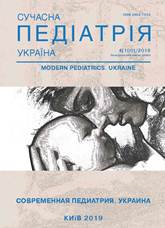Noonan syndrome as result of mutation p. s257l of gene raf1 (clinical case)
Abstract
Noonan syndrome (NS) is a relatively common syndrome of multiple birth defects. The main symptoms are postnatal growth retardation, characterized by facial dysmorphy and a wide range of congenital heart defects. The most common congenital heart disease is pulmonary artery stenosis and hypertrophic cardiomyopathy.
Objektive: to diagnose a child with congenital heart disease, severe hypertrophic cardiomyopathy, pulmonary hypertension and stigmata of dysbryogenesis. RAF1 mutations cause 3–17% of Noonan syndrome cases. Noonan syndrome is one of a group of related conditions, collectively known as RASopathies. The RASopathies are associated with the presence of germline mutation in genes encoding specific proteins of the RAS/mitogen — activated protein kinase (MAPK) pathway that plays a crucial role in embryonic and postnatal development. Here we report on a case of an infant with Noonan syndrome and rapidly progressive hypertrophic cardiomyopathy with lethal outcome, as a result of mutation p.Ser257Leu in the gene RAF1.
The research was carried out in accordance with the principles of the Helsinki Declaration. The study protocol was approved by the Local Ethics Committee (LEC) of institution. The informed consent of the patient was obtained for conducting the studies.
References
Bukaeva AA, Kotlukova NP, Zaklyazminskaya EV. Noonan syndrome as result of mutation p. S257L of gene RAF1: clinical case and review. Russian Journal of Cardiology. 10(138): 93—97. https://doi.org/10.15829/1560-4071-2016-10-93-97
El Bouchikhi I, Belhassan K, Moufid FZ, Iraqui Houssaini M et al. (2016). Noonan syndrome-causing genes: Molecular update and an assessment of the mutation rate. Int J Pediatr Adolesc Med. 3(4): 133—142. https://doi.org/10.1016/j.ijpam.2016.06.003; PMid:30805484 PMCid:PMC6372459.
Hopper RK, Feinstein JA, Manning MA, Benitz W, Hudgins L. (2015). Neonatal pulmonary arterial hypertension and Noonan syndrome: two fatal cases with a specific RAF1 mutation. Am J Med Genet A. 167A(4): 882—5. https://doi.org/10.1002/ajmg.a.37024; PMid:25706034.
Ineke van der Burgt. (2007). Noonan syndrome. Orphanet J Rare Dis. 14; 2: 4. doi 10.1186/1750-1172-2-4. https://doi.org/10.1186/1750-1172-2-4; PMid:17222357 PMCid:PMC1781428
Kuburovic V, Vukomanovic V, Carcavilla A, Ezquieta4Zubicaray B, Kuburovic N et al. (2011). Two cases of LEOPARD syndrome -RAF1 mutations firstly described in children. Pediatr. 53(6): 687—91.
Pierpont EI, Pierpont ME, Mendelsohn NJ, Roberts AE, Tworog4Dube E, Seidenberg MS. (2009). Genotype differences in cognitive functioning in Noonan syndrome. Genes Brain Behav. 8(3): 275—82. https://doi.org/10.1111/j.1601-183X.2008.00469.x; PMid:19077116 PMCid:PMC2760992.
Rauen KA. (2013). The RASopathies. Annu Rev Genomics Hum Genet. 14: 355—69. https://doi.org/10.1146/annurev-genom-091212-153523; PMid:23875798 PMCid:PMC4115674
Roberts AE, Allanson JE, Tartaglia M, Gelb BD. (2013). Noonan syndrome. Lancet. 26;381(9863): 333—42. https://doi.org/10.1016/S0140-6736(12)61023-X
Shaw AC, Kalidas K, Crosby AH, Jeffery S, Patton MA (2007). The natural history of Noonan syndrome: a long-term follow-up study. Arch Dis Child. 92: 128—32. https://doi.org/10.1136/adc.2006.104547; PMid:16990350 PMCid:PMC2083343
Tartaglia M, Zampino G, Gelb BD (2010). Noonan syndrome: clinical aspects and molecular pathogenesis. Mol Syndromol. 1(1): 2—26. https://doi.org/10.1159/000276766; PMid:20648242 PMCid:PMC2858523.
Tidyman WE, Rauen KA (2009). The RASopathies: developmental syndromes of Ras/MAPK pathway dysregulation. Curr Opin Genet Dev. 19(3): 230—6. https://doi.org/10.1016/j.gde.2009.04.001; PMid:19467855 PMCid:PMC2743116
Downloads
Issue
Section
License
The policy of the Journal “MODERN PEDIATRICS. UKRAINE” is compatible with the vast majority of funders' of open access and self-archiving policies. The journal provides immediate open access route being convinced that everyone – not only scientists - can benefit from research results, and publishes articles exclusively under open access distribution, with a Creative Commons Attribution-Noncommercial 4.0 international license (СС BY-NC).
Authors transfer the copyright to the Journal “MODERN PEDIATRICS. UKRAINE” when the manuscript is accepted for publication. Authors declare that this manuscript has not been published nor is under simultaneous consideration for publication elsewhere. After publication, the articles become freely available on-line to the public.
Readers have the right to use, distribute, and reproduce articles in any medium, provided the articles and the journal are properly cited.
The use of published materials for commercial purposes is strongly prohibited.

